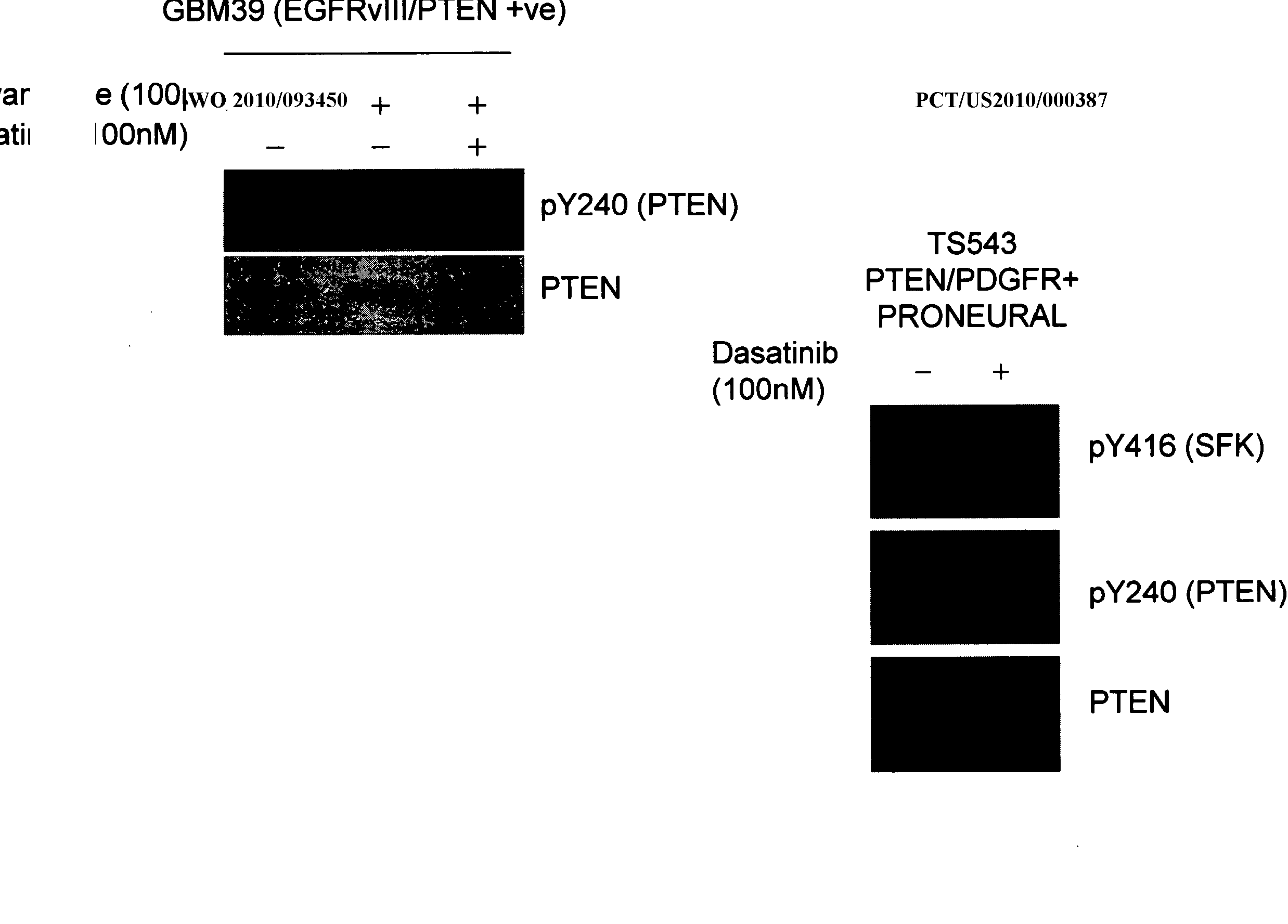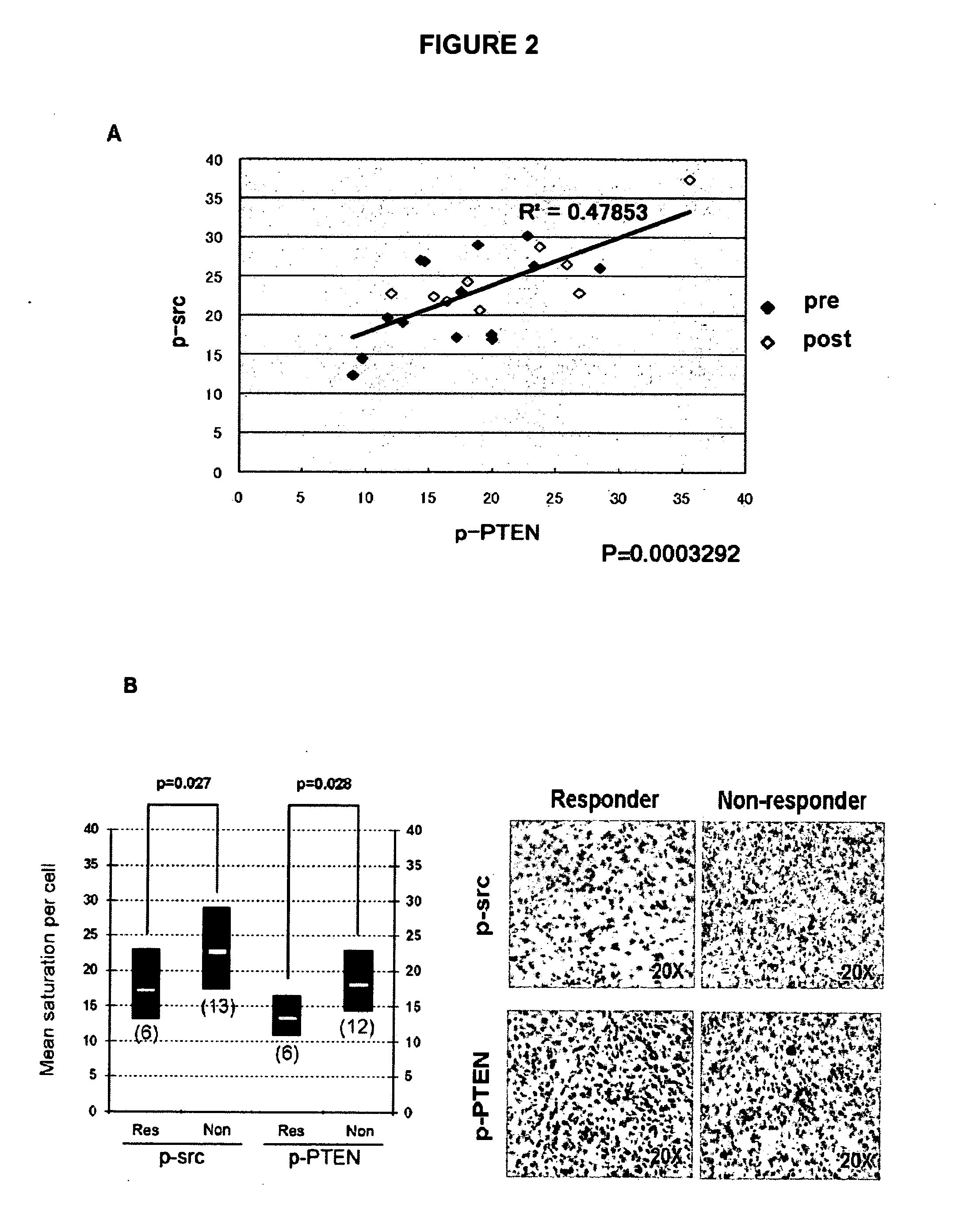Pten phosphorylation-driven resistance to cancer treatment and altered patient prognosis
a phosphorylation-driven resistance and cancer treatment technology, applied in the field of indicators, can solve the problems of poor prognosis or reduced survival time from diagnosis, and achieve the effects of poorer prognosis, poorer prognosis, and altered sensitivity or resistance to targeted cancer treatmen
- Summary
- Abstract
- Description
- Claims
- Application Information
AI Technical Summary
Benefits of technology
Problems solved by technology
Method used
Image
Examples
example 1
[0181]Glioblastoma multiforme (GBM) is the most aggressive of the astrocytic malignancies and the most common intracranial tumour in adults. Those patients with GBMs expressing the mutant epidermal growth factor receptor, EGFRvIII, together with the PTEN tumor suppressor show initial clinical responses to the EGFR kinase inhibitors erlotinib or gefitinib2, 3. However, not all patients whose tumors have this genotype responded and, for those who did, the responses were often short-lived before tumors acquired resistance. Using mass spectrometry, we have mapped Src-induced phosphorylation sites on PTEN. For the first time, we directly demonstrate tyrosine phosphorylation of PTEN in human tumors, particularly in those GBMs that retain wild type PTEN but fail to respond to EGFR inhibitors. Using a PTEN allele in which a single tyrosine residue, Y240 is mutated to phenylalanine, we show that the modification at this site modulates EGFRvIII signaling and the cellular response to Erlotinib...
example 2
[0240]To further evaluate PTEN in a clinical setting, glioblastoma (GBM) patient samples at initial diagnosis were evaluated for expression of PTEN, PY240PTEN, EGFR and EGFRvIII. The expression of these and overall survival of the patients is noted in Table 2. These patients had received surgical resection, radiotherapy and chemotherapy with BCNU but no targeted cancer or EGFR therapy.
TABLE 2n ofoverexpressiontotaloverallcasesEGFREGFRvIIIPTENpY240Survival (mo)8++−23.88 ± 7.1120+++10.85 ± 3.2511−+− 8.91 ± 7.4218−++13.39 ± 15.0527−++15.37 ± 3.8417−+−15.05 ± 16.5811+++ 7.18 ± 1.362++− 16 ± 20.51
[0241]Mean survival time: includes cases of GBM dead (survival time) and alive (follow up time).
[0242]Cumulative survival of glioblastoma patients with EGFR overexpression, PTEN expression and no Y240 PTEN phosphorylation versus those with phosphorylated Y240 PTEN is shown graphically in FIG. 10. Mean survival of patients without PTEN Y240 phosphorylation was 23.88 months, while mean survival o...
example 3
[0255]In the above studies, we established that:
1) PTEN can be phosphorylated on tyrosine 240 upon co-expression with the canonical src-family kinase member, pp 60-src.
2) Tyrosine 240 phosphorylation is correlated with src-family kinase activation in glioblastoma clinical samples.
3) That inhibition of src-family kinases blocks tyrosine 240 phosphorylation in glioblastoma cell lines.
[0256]We now set out to specifically identify the src family kinase(s) responsible for Y-240 phosphorylation observed on PTEN. Previous reports have implicated three src family kinases in glioblastoma: src, fyn and lyn (Stettner et al, 2005; Lu et al, 2009). Having failed to detect PTEN phosphorylation in the U87MG cell line, which expresses Fyn and src but not lyn (data not shown), we investigated whether Lyn may be the src family kinase member responsible for the Y240 phosphorylation we observed in clinical samples. Upon co-expression of the Lyn cDNA with PTEN in HEK 293 cells, we observed a robust phos...
PUM
| Property | Measurement | Unit |
|---|---|---|
| pH | aaaaa | aaaaa |
| temperature | aaaaa | aaaaa |
| Tm | aaaaa | aaaaa |
Abstract
Description
Claims
Application Information
 Login to View More
Login to View More - R&D
- Intellectual Property
- Life Sciences
- Materials
- Tech Scout
- Unparalleled Data Quality
- Higher Quality Content
- 60% Fewer Hallucinations
Browse by: Latest US Patents, China's latest patents, Technical Efficacy Thesaurus, Application Domain, Technology Topic, Popular Technical Reports.
© 2025 PatSnap. All rights reserved.Legal|Privacy policy|Modern Slavery Act Transparency Statement|Sitemap|About US| Contact US: help@patsnap.com



